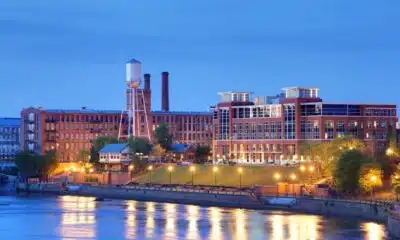Kaiser Health News
Facing Financial Ruin as Costs Soar for Elder Care
Reed Abelson, The New York Times and Jordan Rau, KFF Health News
Tue, 14 Nov 2023 10:35:00 +0000
Margaret Newcomb, 69, a retired French teacher, is desperately trying to protect her retirement savings by caring for her 82-year-old husband, who has severe dementia, at home in Seattle. She used to fear his disease-induced paranoia, but now he’s so frail and confused that he wanders away with no idea of how to find his way home. He gets lost so often that she attaches a tag to his shoelace with her phone number.
Feylyn Lewis, 35, sacrificed a promising career as a research director in England to return home to Nashville after her mother had a debilitating stroke. They ran up $15,000 in medical and credit card debt while she took on the role of caretaker.
Sheila Littleton, 30, brought her grandfather with dementia to her family home in Houston, then spent months fruitlessly trying to place him in a nursing home with Medicaid coverage. She eventually abandoned him at a psychiatric hospital to force the system to act.
“That was terrible,” she said. “I had to do it.”
Millions of families are facing such daunting life choices — and potential financial ruin — as the escalating costs of in-home care, assisted living facilities, and nursing homes devour the savings and incomes of older Americans and their relatives.
“People are exposed to the possibility of depleting almost all their wealth,” said Richard Johnson, director of the program on retirement policy at the Urban Institute.
The prospect of dying broke looms as an imminent threat for the boomer generation, which vastly expanded the middle class and looked hopefully toward a comfortable retirement on the backbone of 401(k)s and pensions. Roughly 10,000 of them will turn 65 every day until 2030, expecting to live into their 80s and 90s as the price tag for long-term care explodes, outpacing inflation and reaching a half-trillion dollars a year, according to federal researchers.
The challenges will only grow. By 2050, the population of Americans 65 and older is projected to increase by more than 50%, to 86 million, according to census estimates. The number of people 85 or older will nearly triple to 19 million.
The United States has no coherent system of long-term care, mostly a patchwork. The private market, where a minuscule portion of families buy long-term care insurance, has shriveled, reduced over years of giant rate hikes by insurers that had underestimated how much care people would actually use. Labor shortages have left families searching for workers willing to care for their elders in the home. And the cost of a spot in an assisted living facility has soared to an unaffordable level for most middle-class Americans. They have to run out of money to qualify for nursing home care paid for by the government.
For an examination of the crisis in long-term care, The New York Times and KFF Health News interviewed families across the nation as they struggled to obtain care; examined companies that provide it; and analyzed data from the federally funded Health and Retirement Study, the most authoritative national survey of older people about their long-term care needs and financial resources.
About 8 million people 65 and older reported that they had dementia or difficulty with basic daily tasks like bathing and feeding themselves — and nearly 3 million of them had no assistance at all, according to an analysis of the survey data. Most people relied on spouses, children, grandchildren, or friends.
The United States devotes a smaller share of its gross domestic product to long-term care than do most other wealthy countries, including Britain, France, Canada, Germany, Sweden, and Japan, according to the Organization for Economic Cooperation and Development. The United States lags its international peers in another way: It dedicates far less of its overall health spending toward long-term care.
“We just don’t value elders the way that other countries and other cultures do,” said Rachel Werner, executive director of the Leonard Davis Institute of Health Economics at the University of Pennsylvania. “We don’t have a financing and insurance system for long-term care,” she said. “There isn’t the political will to spend that much money.”
Despite medical advances that have added years to the average life span and allowed people to survive decades more after getting cancer or suffering from heart disease or strokes, federal long-term care for older people has not fundamentally changed in the decades since President Lyndon Johnson signed Medicare and Medicaid into law in 1965. From 1960 to 2021, the number of Americans age 85 and older increased at more than six times the rate of the general population, according to census records.
Medicare, the federal health insurance program for Americans 65 and older, covers the costs of medical care, but generally pays for a home aide or a stay in a nursing home only for a limited time during a recovery from a surgery or a fall or for short-term rehabilitation.
Medicaid, the federal-state program, covers long-term care, usually in a nursing home, but only for the poor. Middle-class people must exhaust their assets to qualify, forcing them to sell much of their property and to empty their bank accounts. If they go into a nursing home, they are permitted to keep a pittance of their retirement income: $50 or less a month in a majority of states. And spouses can hold onto only a modest amount of income and assets, often leaving their children and grandchildren to shoulder some of the financial burden.
“You basically want people to destitute themselves and then you take everything else that they have,” said Gay Glenn, whose mother lived in a nursing home in Kansas until she died in October at age 96.
Her mother, Betty Mae Glenn, had to spend down her savings, paying the home more than $10,000 a month, until she qualified for Medicaid. Glenn, 61, relocated from Chicago to Topeka more than four years ago, moving into one of her mother’s two rental properties and overseeing her care and finances.
Under the state Medicaid program’s byzantine rules, she had to pay rent to her mother, and that income went toward her mother’s care. Glenn sold the family’s house just before her mother’s death in October. Her lawyer told her the estate had to pay Medicaid back about $20,000 from the proceeds.
A play she wrote about her relationship with her mother, titled “If You See Panic in My Eyes,” was read this year at a theater festival.
At any given time, skilled nursing homes house roughly 630,000 older residents whose average age is about 77, according to recent estimates. A long-term resident’s care can easily cost more than $100,000 a year without Medicaid coverage at these institutions, which are supposed to provide round-the-clock nursing coverage.
Nine in 10 people said it would be impossible or very difficult to pay that much, according to a KFF public opinion poll conducted during the pandemic.
Efforts to create a national long-term care system have repeatedly collapsed. Democrats have argued that the federal government needs to take a much stronger hand in subsidizing care. The Biden administration sought to improve wages and working conditions for paid caregivers. But a $150 billion proposal in the Build Back Better Act for in-home and community-based services under Medicaid was dropped to lower the price tag of the final legislation.
“This is an issue that’s coming to the front door of members of Congress,” said Sen. Bob Casey, a Pennsylvania Democrat and chair of the Senate Special Committee on Aging. “No matter where you’re representing — if you’re representing a blue state or red state — families are not going to settle for just having one option,” he said, referring to nursing homes funded under Medicaid. “The federal government has got to do its part, which it hasn’t.”
But leading Republicans in Congress say the federal government cannot be expected to step in more than it already does. Americans need to save for when they will inevitably need care, said Sen. Mike Braun of Indiana, the ranking Republican on the aging committee.
“So often people just think it’s just going to work out,” he said. “Too many people get to the point where they’re 65 and then say, ‘I don’t have that much there.’”
Private Companies’ Prices Have Skyrocketed
The boomer generation is jogging and cycling into retirement, equipped with hip and knee replacements that have slowed their aging. And they are loath to enter the institutional setting of a nursing home.
But they face major expenses for the in-between years: falling along a spectrum between good health and needing round-the-clock care in a nursing home.
That has led them to assisted living centers run by for-profit companies and private equity funds enjoying robust profits in this growing market. Some 850,000 people age 65 or older now live in these facilities that are largely ineligible for federal funds and run the gamut, with some providing only basics like help getting dressed and taking medication and others offering luxury amenities like day trips, gourmet meals, yoga, and spas.
The bills can be staggering.
Half of the nation’s assisted living facilities cost at least $54,000 a year, according to Genworth, a long-term care insurer. That rises substantially in many metropolitan areas with lofty real estate prices. Specialized settings, like locked memory care units for those with dementia, can cost twice as much.
Home care is costly, too. Agencies charge about $27 an hour for a home health aide, according to Genworth. Hiring someone who spends six or seven hours a day cleaning and helping an older person get out of bed or take medications can add up to $60,000 a year.
As Americans live longer, the number who develop dementia, a condition of aging, has soared, as have their needs. Five million to 7 million Americans age 65 and up have dementia, and their ranks are projected to grow to nearly 12 million by 2040. The condition robs people of their memories, mars the ability to speak and understand, and can alter their personalities.
In Seattle, Margaret and Tim Newcomb sleep on separate floors of their two-story cottage, with Margaret ever mindful that her husband, who has dementia, can hallucinate and become aggressive if medication fails to tame his symptoms.
“The anger has diminished from the early days,” she said last year.
But earlier on, she had resorted to calling the police when he acted erratically.
“He was hating me and angry, and I didn’t feel safe,” she said.
She considered memory care units, but the least expensive option cost around $8,000 a month and some could reach nearly twice that amount. The couple’s monthly income, with his pension from Seattle City Light, the utility company, and their combined Social Security, is $6,000.
Placing her husband in such a place would have gutted the $500,000 they had saved before she retired from 35 years teaching art and French at a parochial school.
“I’ll let go of everything if I have to, but it’s a very unfair system,” she said. “If you didn’t see ahead or didn’t have the right type of job that provides for you, it’s tough luck.”
In the last year, medication has quelled Tim’s anger, but his health has declined so much that he no longer poses a physical threat. Margaret said she’s reconciled to caring for him as long as she can.
“When I see him sitting out on the porch and appreciating the sun coming on his face, it’s really sweet,” she said.
The financial threat posed by dementia also weighs heavily on adult children who have become guardians of aged parents and have watched their slow, expensive declines.
Claudia Morrell, 64, of Parkville, Maryland, estimated her mother, Regine Hayes, spent more than $1 million during the eight years she needed residential care for dementia. That was possible only because her mother had two pensions, one from her husband’s military service and another from his job at an insurance company, plus savings and Social Security.
Morrell paid legal fees required as her mother’s guardian, as well as $6,000 on a special bed so her mother wouldn’t fall out and on private aides after she suffered repeated small strokes. Her mother died last December at age 87.
“I will never have those kinds of resources,” Morrell, an education consultant, said. “My children will never have those kinds of resources. We didn’t inherit enough or aren’t going to earn enough to have the quality of care she got. You certainly can’t live that way on Social Security.”
Women Bear the Burden of Care
For seven years, Annie Reid abandoned her life in Colorado to sleep in her childhood bedroom in Maryland, living out of her suitcase and caring for her mother, Frances Sampogna, who had dementia. “No one else in my family was able to do this,” she said.
“It just dawned on me, I have to actually unpack and live here,” Reid, 61, remembered thinking. “And how long? There’s no timeline on it.”
After Sampogna died at the end of September 2022, her daughter returned to Colorado and started a furniture redesign business, a craft she taught herself in her mother’s basement. Reid recently had her knee replaced, something she could not do in Maryland because her insurance didn’t cover doctors there.
“It’s amazing how much time went by,” she said. “I’m so grateful to be back in my life again.”
Studies are now calculating the toll of caregiving on children, especially women. The median lost wages for women providing intensive care for their mothers is $24,500 over two years, according to a study led by Norma Coe, an associate professor at the Perelman School of Medicine at the University of Pennsylvania.
Lewis moved back from England to Nashville to care for her mother, a former nurse who had a stroke that put her in a wheelchair.
“I was thrust back into a caregiving role full time,” she said. She gave up a post as a research director for a nonprofit organization. She is also tending to her 87-year-old grandfather, ill with prostate cancer and kidney disease.
Making up for lost income seems daunting while she continues to support her mother.
But she is regaining hope: She was promoted to assistant dean for student affairs at Vanderbilt School of Nursing and was recently married. She and her husband plan to stay in the same apartment with her mother until they can save enough to move into a larger place.
Government Solutions Are Elusive
Over the years, lawmakers in Congress and government officials have sought to ease the financial burdens on individuals, but little has been achieved.
The CLASS Act, part of the Obamacare legislation of 2010, was supposed to give people the option of paying into a long-term insurance program. It was repealed two years later amid compelling evidence that it would never be economically viable.
Two years ago, another proposal, called the WISH Act, outlined a long-term care trust fund, but it never gained traction.
On the home care front, the scarcity of workers has led to a flurry of attempts to improve wages and working conditions for paid caregivers. A provision in the Build Back Better Act to provide more funding for home care under Medicaid was not included in the final Inflation Reduction Act, a less costly version of the original bill that Democrats sought to pass last year.
The labor shortages are largely attributed to low wages for difficult work. In the Medicaid program, demand has clearly outstripped supply, according to a recent analysis. While the number of home aides in the Medicaid program has increased to 1.4 million in 2019 from 840,000 in 2008, the number of aides per 100 people who qualify for home or community care has declined nearly 12%.
In April, President Joe Biden signed an executive order calling for changes to government programs that would improve conditions for workers and encourage initiatives that would relieve some of the burdens on families providing care.
Turning to Medicaid, a Shredded Safety Net
The only true safety net for many Americans is Medicaid, which represents, by far, the largest single source of funding for long-term care.
More than 4 in 5 middle-class people 65 or older who need long-term care for five years or more will eventually enroll, according to an analysis for the federal government by the Urban Institute. Almost half of upper-middle-class couples with lifetime earnings of more than $4.75 million will also end up on Medicaid.
But gaps in Medicaid coverage leave many people without care. Under federal law, the program is obliged to offer nursing home care in every state. In-home care, which is not guaranteed, is provided under state waivers, and the number of participants is limited. Many states have long waiting lists, and it can be extremely difficult to find aides willing to work at the low-paying Medicaid rate.
Qualifying for a slot in a nursing home paid by Medicaid can be formidable, with many families spending thousands of dollars on lawyers and consultants to navigate state rules. Homes may be sold or couples may contemplate divorce to become eligible.
And recipients and their spouses may still have to contribute significant sums. After Stan Markowitz, a former history professor in Baltimore with Parkinson’s disease, and his wife, Dottye Burt, 78, exhausted their savings on his two-year stay in an assisted living facility, he qualified for Medicaid and moved into a nursing home.
He was required to contribute $2,700 a month, which ate up 45% of the couple’s retirement income. Burt, who was a racial justice consultant for nonprofits, rented a modest apartment near the home, all she could afford on what was left of their income.
Markowitz died in September at age 86, easing the financial pressure on her. “I won’t be having to pay the nursing home,” she said.
Even finding a place willing to take someone can be a struggle. Harold Murray, Sheila Littleton’s grandfather, could no longer live safely in rural North Carolina because his worsening dementia led him to wander. She brought him to Houston in November 2020, then spent months trying to enroll him in the state’s Medicaid program so he could be in a locked unit at a nursing home.
She felt she was getting the runaround. Nursing home after nursing home told her there were no beds, or quibbled over when and how he would be eligible for a bed under Medicaid. In desperation, she left him at a psychiatric hospital so it would find him a spot.
“I had to refuse to take him back home,” she said. “They had no choice but to place him.”
He was finally approved for coverage in early 2022, at age 83.
A few months later, he died.
Reed Abelson is a health care reporter for The New York Times. The New York Times’ Kirsten Noyes and graphics editor Albert Sun, KFF Health News data editor Holly K. Hacker, and JoNel Aleccia, formerly of KFF Health News, contributed to this report.
US Health and Retirement Study Analysis
The New York Times-KFF Health News data analysis was based on the Health and Retirement Study, a nationally representative longitudinal survey of about 20,000 people age 50 and older. The analysis defined people age 65 and above as likely to need long-term care if they were assessed to have dementia, or if they reported having difficulty with two or more of six specified activities of daily living: bathing, dressing, eating, getting in and out of bed, walking across a room, and using the toilet. The Langa-Weir classification of cognitive function, a related data set, was used to identify respondents with dementia. The analysis’s definition of needing long-term care assistance is conservative and in line with the criteria most long-term care insurers use in determining whether they will pay for services.
People were described as recipients of long-term care help if they reported receiving assistance in the month before the interview for the study or if they lived in a nursing home. The analysis was developed in consultation with Norma Coe, an associate professor of medical ethics and health policy at the Perelman School of Medicine at the University of Pennsylvania.
The financial toll on middle-class and upper-income people needing long-term care was examined by reviewing data that the HRS collected from 2000 to 2021 on wealthy Americans, those whose net worth at age 65 was in the 50th to 95th percentile, totaling anywhere from $171,365 to $1,827,765 in inflation-adjusted 2020 dollars. This group excludes the super-wealthy. Each individual’s wealth at age 65 was compared with their wealth just before they died to calculate the percentage of affluent people who exhausted their financial resources and the likelihood that would occur among different groups.
To calculate how many people were likely to need long-term care, how many people needing long-term care services were receiving them, and who was providing care to people receiving help, we looked at people age 65 and older of all wealth levels in the 2020-21 survey, the most recent.
The U.S. Health and Retirement Study is conducted by the University of Michigan and funded by the National Institute on Aging and the Social Security Administration.
——————————
By: Reed Abelson, The New York Times and Jordan Rau, KFF Health News
Title: Facing Financial Ruin as Costs Soar for Elder Care
Sourced From: kffhealthnews.org/news/article/dying-broke-facing-financial-ruin-as-costs-soar-for-elder-care/
Published Date: Tue, 14 Nov 2023 10:35:00 +0000
Kaiser Health News
Dual Threats From Trump and GOP Imperil Nursing Homes and Their Foreign-Born Workers
In a top-rated nursing home in Alexandria, Virginia, the Rev. Donald Goodness is cared for by nurses and aides from various parts of Africa. One of them, Jackline Conteh, a naturalized citizen and nurse assistant from Sierra Leone, bathes and helps dress him most days and vigilantly intercepts any meal headed his way that contains gluten, as Goodness has celiac disease.
“We are full of people who come from other countries,” Goodness, 92, said about Goodwin House Alexandria’s staff. Without them, the retired Episcopal priest said, “I would be, and my building would be, desolate.”
The long-term health care industry is facing a double whammy from President Donald Trump’s crackdown on immigrants and the GOP’s proposals to reduce Medicaid spending. The industry is highly dependent on foreign workers: More than 800,000 immigrants and naturalized citizens comprise 28% of direct care employees at home care agencies, nursing homes, assisted living facilities, and other long-term care companies.
But in January, the Trump administration rescinded former President Joe Biden’s 2021 policy that protected health care facilities from Immigration and Customs Enforcement raids. The administration’s broad immigration crackdown threatens to drastically reduce the number of current and future workers for the industry. “People may be here on a green card, and they are afraid ICE is going to show up,” said Katie Smith Sloan, president of LeadingAge, an association of nonprofits that care for older adults.
Existing staffing shortages and quality-of-care problems would be compounded by other policies pushed by Trump and the Republican-led Congress, according to nursing home officials, resident advocates, and academic experts. Federal spending cuts under negotiation may strip nursing homes of some of their largest revenue sources by limiting ways states leverage Medicaid money and making it harder for new nursing home residents to retroactively qualify for Medicaid. Care for 6 in 10 residents is paid for by Medicaid, the state-federal health program for poor or disabled Americans.
“We are facing the collision of two policies here that could further erode staffing in nursing homes and present health outcome challenges,” said Eric Roberts, an associate professor of internal medicine at the University of Pennsylvania.
The industry hasn’t recovered from covid-19, which killed more than 200,000 long-term care facility residents and workers and led to massive staff attrition and turnover. Nursing homes have struggled to replace licensed nurses, who can find better-paying jobs at hospitals and doctors’ offices, as well as nursing assistants, who can earn more working at big-box stores or fast-food joints. Quality issues that preceded the pandemic have expanded: The percentage of nursing homes that federal health inspectors cited for putting residents in jeopardy of immediate harm or death has risen alarmingly from 17% in 2015 to 28% in 2024.
In addition to seeking to reduce Medicaid spending, congressional Republicans have proposed shelving the biggest nursing home reform in decades: a Biden-era rule mandating minimum staffing levels that would require most of the nation’s nearly 15,000 nursing homes to hire more workers.
The long-term care industry expects demand for direct care workers to burgeon with an influx of aging baby boomers needing professional care. The Census Bureau has projected the number of people 65 and older would grow from 63 million this year to 82 million in 2050.
In an email, Vianca Rodriguez Feliciano, a spokesperson for the Department of Health and Human Services, said the agency “is committed to supporting a strong, stable long-term care workforce” and “continues to work with states and providers to ensure quality care for older adults and individuals with disabilities.” In a separate email, Tricia McLaughlin, a Department of Homeland Security spokesperson, said foreigners wanting to work as caregivers “need to do that by coming here the legal way” but did not address the effect on the long-term care workforce of deportations of classes of authorized immigrants.
Goodwin Living, a faith-based nonprofit, runs three retirement communities in northern Virginia for people who live independently, need a little assistance each day, have memory issues, or require the availability of around-the-clock nurses. It also operates a retirement community in Washington, D.C. Medicare rates Goodwin House Alexandria as one of the best-staffed nursing homes in the country. Forty percent of the organization’s 1,450 employees are foreign-born and are either seeking citizenship or are already naturalized, according to Lindsay Hutter, a Goodwin spokesperson.
“As an employer, we see they stay on with us, they have longer tenure, they are more committed to the organization,” said Rob Liebreich, Goodwin’s president and CEO.
Jackline Conteh spent much of her youth shuttling between Sierra Leone, Liberia, and Ghana to avoid wars and tribal conflicts. Her mother was killed by a stray bullet in her home country of Liberia, Conteh said. “She was sitting outside,” Conteh, 56, recalled in an interview.
Conteh was working as a nurse in a hospital in Sierra Leone in 2009 when she learned of a lottery for visas to come to the United States. She won, though she couldn’t afford to bring her husband and two children along at the time. After she got a nursing assistant certification, Goodwin hired her in 2012.
Conteh said taking care of elders is embedded in the culture of African families. When she was 9, she helped feed and dress her grandmother, a job that rotated among her and her sisters. She washed her father when he was dying of prostate cancer. Her husband joined her in the United States in 2017; she cares for him because he has heart failure.
“Nearly every one of us from Africa, we know how to care for older adults,” she said.
Her daughter is now in the United States, while her son is still in Africa. Conteh said she sends money to him, her mother-in-law, and one of her sisters.
In the nursing home where Goodness and 89 other residents live, Conteh helps with daily tasks like dressing and eating, checks residents’ skin for signs of swelling or sores, and tries to help them avoid falling or getting disoriented. Of 102 employees in the building, broken up into eight residential wings called “small houses” and a wing for memory care, at least 72 were born abroad, Hutter said.
Donald Goodness grew up in Rochester, New York, and spent 25 years as rector of The Church of the Ascension in New York City, retiring in 1997. He and his late wife moved to Alexandria to be closer to their daughter, and in 2011 they moved into independent living at the Goodwin House. In 2023 he moved into one of the skilled nursing small houses, where Conteh started caring for him.
“I have a bad leg and I can’t stand on it very much, or I’d fall over,” he said. “She’s in there at 7:30 in the morning, and she helps me bathe.” Goodness said Conteh is exacting about cleanliness and will tell the housekeepers if his room is not kept properly.
Conteh said Goodness was withdrawn when he first arrived. “He don’t want to come out, he want to eat in his room,” she said. “He don’t want to be with the other people in the dining room, so I start making friends with him.”
She showed him a photo of Sierra Leone on her phone and told him of the weather there. He told her about his work at the church and how his wife did laundry for the choir. The breakthrough, she said, came one day when he agreed to lunch with her in the dining room. Long out of his shell, Goodness now sits on the community’s resident council and enjoys distributing the mail to other residents on his floor.
“The people that work in my building become so important to us,” Goodness said.
While Trump’s 2024 election campaign focused on foreigners here without authorization, his administration has broadened to target those legally here, including refugees who fled countries beset by wars or natural disasters. This month, the Department of Homeland Security revoked the work permits for migrants and refugees from Cuba, Haiti, Nicaragua, and Venezuela who arrived under a Biden-era program.
“I’ve just spent my morning firing good, honest people because the federal government told us that we had to,” Rachel Blumberg, president of the Toby & Leon Cooperman Sinai Residences of Boca Raton, a Florida retirement community, said in a video posted on LinkedIn. “I am so sick of people saying that we are deporting people because they are criminals. Let me tell you, they are not all criminals.”
At Goodwin House, Conteh is fearful for her fellow immigrants. Foreign workers at Goodwin rarely talk about their backgrounds. “They’re scared,” she said. “Nobody trusts anybody.” Her neighbors in her apartment complex fled the U.S. in December and returned to Sierra Leone after Trump won the election, leaving their children with relatives.
“If all these people leave the United States, they go back to Africa or to their various countries, what will become of our residents?” Conteh asked. “What will become of our old people that we’re taking care of?”
KFF Health News is a national newsroom that produces in-depth journalism about health issues and is one of the core operating programs at KFF—an independent source of health policy research, polling, and journalism. Learn more about KFF.
Subscribe to KFF Health News’ free Morning Briefing.
This article first appeared on KFF Health News and is republished here under a Creative Commons license.
The post Dual Threats From Trump and GOP Imperil Nursing Homes and Their Foreign-Born Workers appeared first on kffhealthnews.org
Note: The following A.I. based commentary is not part of the original article, reproduced above, but is offered in the hopes that it will promote greater media literacy and critical thinking, by making any potential bias more visible to the reader –Staff Editor.
Political Bias Rating: Center-Left
This content primarily highlights concerns about the impact of restrictive immigration policies and Medicaid spending cuts proposed by the Trump administration and Republican lawmakers on the long-term care industry. It emphasizes the importance of immigrant workers in healthcare, the challenges that staffing shortages pose to patient care, and the potential negative effects of GOP policy proposals. The tone is critical of these policies while sympathetic toward immigrant workers and advocates for maintaining or increasing government support for healthcare funding. The framing aligns with a center-left perspective, focusing on social welfare, immigrant rights, and concern about the consequences of conservative economic and immigration policies without descending into partisan rhetoric.
Kaiser Health News
California’s Much-Touted IVF Law May Be Delayed Until 2026, Leaving Many in the Lurch
California lawmakers are poised to delay the state’s much-ballyhooed new law mandating in vitro fertilization insurance coverage for millions, set to take effect July 1. Gov. Gavin Newsom has asked lawmakers to push the implementation date to January 2026, leaving patients, insurers, and employers in limbo.
The law, SB 729, requires state-regulated health plans offered by large employers to cover infertility diagnosis and treatment, including IVF. Nine million people will qualify for coverage under the law. Advocates have praised the law as “a major win for Californians,” especially in making same-sex couples and aspiring single parents eligible, though cost concerns limited the mandate’s breadth.
People who had been planning fertility care based on the original timeline are now “left in a holding pattern facing more uncertainty, financial strain, and emotional distress,” Alise Powell, a director at Resolve: The National Infertility Association, said in a statement.
During IVF, a patient’s eggs are retrieved, combined with sperm in a lab, and then transferred to a person’s uterus. A single cycle can total around $25,000, out of reach for many. The California law requires insurers to cover up to three egg retrievals and an unlimited number of embryo transfers.
Not everyone’s coverage would be affected by the delay. Even if the law took effect July 1, it wouldn’t require IVF coverage to start until the month an employer’s contract renews with its insurer. Rachel Arrezola, a spokesperson for the California Department of Managed Health Care, said most of the employers subject to the law renew their contracts in January, so their employees would not be affected by a delay.
She declined to provide data on the percentage of eligible contracts that renew in July or later, which would mean those enrollees wouldn’t get IVF coverage until at least a full year from now, in July 2026 or later.
The proposed new implementation date comes amid heightened national attention on fertility coverage. California is now one of 15 states with an IVF mandate, and in February, President Donald Trump signed an executive order seeking policy recommendations to expand IVF access.
It’s the second time Newsom has asked lawmakers to delay the law. When the Democratic governor signed the bill in September, he asked the legislature to consider delaying implementation by six months. The reason, Newsom said then, was to allow time to reconcile differences between the bill and a broader effort by state regulators to include IVF and other fertility services as an essential health benefit, which would require the marketplace and other individual and small-group plans to provide the coverage.
Newsom spokesperson Elana Ross said the state needs more time to provide guidance to insurers on specific services not addressed in the law to ensure adequate and uniform coverage. Arrezola said embryo storage and donor eggs and sperm were examples of services requiring more guidance.
State Sen. Caroline Menjivar, a Democrat who authored the original IVF mandate, acknowledged a delay could frustrate people yearning to expand their families, but requested patience “a little longer so we can roll this out right.”
Sean Tipton, a lobbyist for the American Society for Reproductive Medicine, contended that the few remaining questions on the mandate did not warrant a long delay.
Lawmakers appear poised to advance the delay to a vote by both houses of the legislature, likely before the end of June. If a delay is approved and signed by the governor, the law would immediately be paused. If this does not happen before July 1, Arrezola said, the Department of Managed Health Care would enforce the mandate as it exists. All plans were required to submit compliance filings to the agency by March. Arrezola was unable to explain what would happen to IVF patients whose coverage had already begun if the delay passes after July 1.
The California Association of Health Plans, which opposed the mandate, declined to comment on where implementation efforts stand, although the group agrees that insurers need more guidance, spokesperson Mary Ellen Grant said.
Kaiser Permanente, the state’s largest insurer, has already sent employers information they can provide to their employees about the new benefit, company spokesperson Kathleen Chambers said. She added that eligible members whose plans renew on or after July 1 would have IVF coverage if implementation of the law is not delayed.
Employers and some fertility care providers appear to be grappling over the uncertainty of the law’s start date. Amy Donovan, a lawyer at insurance brokerage and consulting firm Keenan & Associates, said the firm has fielded many questions from employers about the possibility of delay. Reproductive Science Center and Shady Grove Fertility, major clinics serving different areas of California, posted on their websites that the IVF mandate had been delayed until January 2026, which is not yet the case. They did not respond to requests for comment.
Some infertility patients confused over whether and when they will be covered have run out of patience. Ana Rios and her wife, who live in the Central Valley, had been trying to have a baby for six years, dipping into savings for each failed treatment. Although she was “freaking thrilled” to learn about the new law last fall, Rios could not get clarity from her employer or health plan on whether she was eligible for the coverage and when it would go into effect, she said. The couple decided to go to Mexico to pursue cheaper treatment options.
“You think you finally have a helping hand,” Rios said of learning about the law and then, later, the requested delay. “You reach out, and they take it back.”
This article was produced by KFF Health News, which publishes California Healthline, an editorially independent service of the California Health Care Foundation.
KFF Health News is a national newsroom that produces in-depth journalism about health issues and is one of the core operating programs at KFF—an independent source of health policy research, polling, and journalism. Learn more about KFF.
USE OUR CONTENT
This story can be republished for free (details).
KFF Health News is a national newsroom that produces in-depth journalism about health issues and is one of the core operating programs at KFF—an independent source of health policy research, polling, and journalism. Learn more about KFF.
Subscribe to KFF Health News’ free Morning Briefing.
This article first appeared on KFF Health News and is republished here under a Creative Commons license.
The post California’s Much-Touted IVF Law May Be Delayed Until 2026, Leaving Many in the Lurch appeared first on kffhealthnews.org
Note: The following A.I. based commentary is not part of the original article, reproduced above, but is offered in the hopes that it will promote greater media literacy and critical thinking, by making any potential bias more visible to the reader –Staff Editor.
Political Bias Rating: Center-Left
This content is presented in a factual, balanced manner typical of center-left public policy reporting. It focuses on a progressive healthcare issue (mandated IVF insurance coverage) favorably highlighting benefits for diverse family structures and individuals, including same-sex couples and single parents, which often aligns with center-left values. At the same time, it includes perspectives from government officials, industry representatives, opponents, and patients, offering a nuanced view without overt ideological framing or partisan rhetoric. The emphasis on healthcare access, social equity, and patient impact situates the coverage within a center-left orientation.
Kaiser Health News
Push To Move OB-GYN Exam Out of Texas Is Piece of AGs’ Broader Reproductive Rights Campaign
Democratic state attorneys general led by those from California, New York, and Massachusetts are pressuring medical professional groups to defend reproductive rights, including medication abortion, emergency abortions, and travel between states for health care in response to recent increases in the number of abortion bans.
The American Medical Association adopted a formal position June 9 recommending that medical certification exams be moved out of states with restrictive abortion policies or made virtual, after 20 attorneys general petitioned to protect physicians who fear legal repercussions because of their work. The petition focused on the American Board of Obstetrics and Gynecology’s certification exams in Dallas, and the subsequent AMA recommendation was hailed as a win for Democrats trying to regain ground after the fall of Roe v. Wade.
“It seems incremental, but there are so many things that go into expanding and maintaining access to care,” said Arneta Rogers, executive director of the Center on Reproductive Rights and Justice at the University of California-Berkeley’s law school. “We see AGs banding together, governors banding together, as advocates work on the ground. That feels somewhat more hopeful — that people are thinking about a coordinated strategy.”
Since the Supreme Court eliminated the constitutional right to an abortion in 2022, 16 states, including Texas, have implemented laws banning abortion almost entirely, and many of them impose criminal penalties on providers as well as options to sue doctors. More than 25 states restrict access to gender-affirming care for trans people, and six of them make it a felony to provide such care to youth.
That’s raised concern among some physicians who fear being charged if they go to those states, even if their home state offers protection to provide reproductive and gender-affirming health care.
Pointing to the recent fining and indictment of a physician in New York who allegedly provided abortion pills to a woman in Texas and a teen in Louisiana, a coalition of physicians wrote in a letter to the American Board of Obstetrics and Gynecology that “the limits of shield laws are tenuous” and that “Texas laws can affect physicians practicing outside of the state as well.”
The campaign was launched by several Democratic attorneys general, including Rob Bonta of California, Andrea Joy Campbell of Massachusetts, and Letitia James of New York, who each have established a reproductive rights unit as a bulwark for their state following the Dobbs decision.
“Reproductive health care and gender-affirming care providers should not have to risk their safety or freedom just to advance in their medical careers,” James said in a statement. “Forcing providers to travel to states that have declared war on reproductive freedom and LGBTQ+ rights is as unnecessary as it is dangerous.”
In their petition, the attorneys general included a letter from Joseph Ottolenghi, medical director at Choices Women’s Medical Center in New York City, who was denied his request to take the test remotely or outside of Texas. To be certified by the American Board of Obstetrics and Gynecology, physicians need to take the in-person exam at its testing facility in Dallas. The board completed construction of its new testing facility last year.
“As a New York practitioner, I have made every effort not to violate any other state’s laws, but the outer contours of these draconian laws have not been tested or clarified by the courts,” Ottolenghi wrote.
Rachel Rebouché, the dean of Temple University’s law school and a reproductive law scholar, said “putting the heft” of the attorneys general behind this effort helps build awareness and a “public reckoning” on behalf of providers. Separately, some doctors have urged medical conferences to boycott states with abortion bans.
Anti-abortion groups, however, see the campaign as forcing providers to conform to abortion-rights views. Donna Harrison, an OB-GYN and the director of research at the American Association of Pro-Life Obstetricians and Gynecologists, described the petition as an “attack not only on pro-life states but also on life-affirming medical professionals.”
Harrison said the “OB-GYN community consists of physicians with values that are as diverse as our nation’s state abortion laws,” and that this diversity “fosters a medical environment of debate and rigorous thought leading to advancements that ultimately serve our patients.”
The AMA’s new policy urges specialty medical boards to host exams in states without restrictive abortion laws, offer the tests remotely, or provide exemptions for physicians. However, the decision to implement any changes to the administration of these exams is up to those boards. There is no deadline for a decision to be made.
The OB-GYN board did not respond to requests for comment, but after the public petition from the attorneys general criticizing it for refusing exam accommodations, the board said that in-person exams conducted at its national center in Dallas “provide the most equitable, fair, secure, and standardized assessment.”
The OB-GYN board emphasized that Texas’ laws apply to doctors licensed in Texas and to medical care within Texas, specifically. And it noted that its exam dates are kept under wraps, and that there have been “no incidents of harm to candidates or examiners across thousands of in-person examinations.”
Democratic state prosecutors, however, warned in their petition that the “web of confusing and punitive state-based restrictions creates a legal minefield for medical providers.” Texas is among the states that have banned doctors from providing gender-affirming care to transgender youth, and it has reportedly made efforts to get records from medical facilities and professionals in other states who may have provided that type of care to Texans.
The Texas attorney general’s office did not respond to requests for comment.
States such as California and New York have laws to block doctors from being extradited under other states’ laws and to prevent sharing evidence against them. But instances that require leveraging these laws could still mean lengthy legal proceedings.
“We live in a moment where we’ve seen actions by executive bodies that don’t necessarily square with what we thought the rules provided,” Rebouché said.
This article was produced by KFF Health News, which publishes California Healthline, an editorially independent service of the California Health Care Foundation.
KFF Health News is a national newsroom that produces in-depth journalism about health issues and is one of the core operating programs at KFF—an independent source of health policy research, polling, and journalism. Learn more about KFF.
USE OUR CONTENT
This story can be republished for free (details).
KFF Health News is a national newsroom that produces in-depth journalism about health issues and is one of the core operating programs at KFF—an independent source of health policy research, polling, and journalism. Learn more about KFF.
Subscribe to KFF Health News’ free Morning Briefing.
This article first appeared on KFF Health News and is republished here under a Creative Commons license.
The post Push To Move OB-GYN Exam Out of Texas Is Piece of AGs’ Broader Reproductive Rights Campaign appeared first on kffhealthnews.org
Note: The following A.I. based commentary is not part of the original article, reproduced above, but is offered in the hopes that it will promote greater media literacy and critical thinking, by making any potential bias more visible to the reader –Staff Editor.
Political Bias Rating: Center-Left
The article presents a viewpoint largely aligned with progressive and Democratic positions on reproductive rights and gender-affirming care. It highlights efforts led by Democratic attorneys general and the American Medical Association to protect abortion access and transgender healthcare amid restrictive state laws, portraying these actions positively. While it includes perspectives from anti-abortion advocates, their views are presented briefly and framed as opposition to the broader pro-choice initiatives. The overall tone and framing emphasize support for reproductive freedom and healthcare protections, reflecting a center-left leaning stance typical of mainstream health policy reporting sympathetic to Democratic policy goals.
-
Mississippi Today6 days ago
Defendant in auditor’s ‘second largest’ embezzlement case in history goes free
-
News from the South - Georgia News Feed6 days ago
Are you addicted to ‘fridge cigarettes’? Here’s what the Gen Z term means
-
The Conversation6 days ago
Toxic algae blooms are lasting longer than before in Lake Erie − why that’s a worry for people and pets
-
News from the South - Tennessee News Feed6 days ago
5 teen boys caught on video using two stolen cars during crash-and-grab at Memphis gas station
-
News from the South - Kentucky News Feed7 days ago
Error that caused Medicaid denials has been corrected, says cabinet in response to auditor letter
-
News from the South - Georgia News Feed7 days ago
GOP mega-bill stuck in US Senate as disputes grow over hospitals and more
-
News from the South - South Carolina News Feed5 days ago
Federal investigation launched into Minnesota after transgender athlete leads team to championship
-
Local News6 days ago
St. Martin trio becomes the first females in Mississippi to sign Flag Football Scholarships

















































